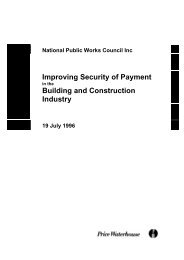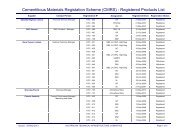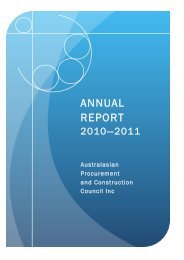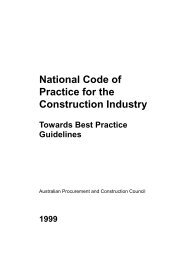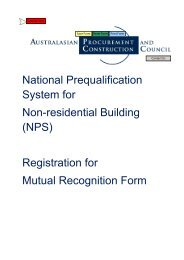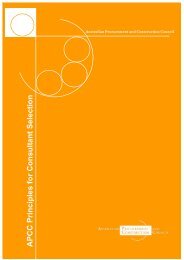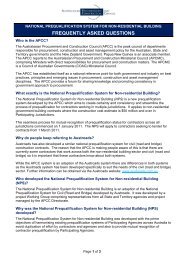(NPS) Guidelines - Australian Procurement and Construction Council
(NPS) Guidelines - Australian Procurement and Construction Council
(NPS) Guidelines - Australian Procurement and Construction Council
Create successful ePaper yourself
Turn your PDF publications into a flip-book with our unique Google optimized e-Paper software.
3.2. Contract Types<br />
Applicants may seek to be prequalified for one or more of the following contract types. (The term<br />
‘Principal’ refers to the client who awards the contract.)<br />
A. Construct/Construct Only:<br />
The Principal under the terms of the contract provides the contractor with the documentation which<br />
fully describes the work to be undertaken. The contractor then builds the works according to the<br />
project documentation prepared by the principal‘s consultants. The contractor may be responsible for<br />
carrying out some design documentation to the extent specified by the contract. The contract can be<br />
based on a lump sum, a schedule of rates <strong>and</strong> lump sums or bill of quantities.<br />
B. Design <strong>and</strong> Construct:<br />
The Contractor is responsible for all or some of the design, including schematic design, design<br />
development, documentation <strong>and</strong> design coordination, as well as construction.<br />
C. Managing Contractor:<br />
The Managing Contractor may be engaged on a project brief, to commission, manage <strong>and</strong> accept<br />
responsibility for consultants that design the works <strong>and</strong> subcontractors that construct the works. The<br />
Principal may also engage a project manager or project director to manage the Managing Contractor<br />
contract <strong>and</strong> to support <strong>and</strong> advise the Principal. A Managing Contractor contract usually involves the<br />
payment of actual reasonable costs (up to a guaranteed or target construction sum(s), where agreed<br />
for construction work, or a guaranteed price for all the work) plus fees.<br />
D. Design, Construct <strong>and</strong> Maintain:<br />
The Contractor is provided with a project brief, generally including some concept designs <strong>and</strong> the<br />
quality <strong>and</strong> performance requirements of the asset are specified. The Contractor is responsible for the<br />
preparation or completion of the concept design, development of the design, preparation of<br />
construction documentation, construction of the asset <strong>and</strong> maintenance for a specified period (say 10<br />
years). Asset condition monitoring indicators are specified, by which the performance of the completed<br />
asset will be measured during the maintenance period.<br />
E. Relationship:<br />
This contract type includes early contractor (or tenderer) involvement (ECI), <strong>and</strong> relationship contracts.<br />
ECI enables the Principal to effectively work with a contractor to better identify <strong>and</strong> allocate risks prior<br />
to, or as part of, a tender process to establish a fixed contract price. It enables contractors to<br />
commence the pricing phase with a full underst<strong>and</strong>ing of the contract requirements. It also enables the<br />
Principal to monitor contractor performance against Key Performance Indicators (KPIs) <strong>and</strong> effectively<br />
work with the Contractor to resolve issues in advance, settling the price, time <strong>and</strong> other parameters of<br />
the contract. ECI may be an effective early component of all the above contracting types aligned with<br />
cooperative contracting.<br />
3.3. Financial Levels<br />
Applicants should note that each Participating Agency reserves the right to:<br />
<br />
<br />
require an updated financial assessment to be undertaken at any time<br />
impose a financial limit on the value of a contract that can be undertaken by a contractor within<br />
its jurisdiction.<br />
Page 10 of 20


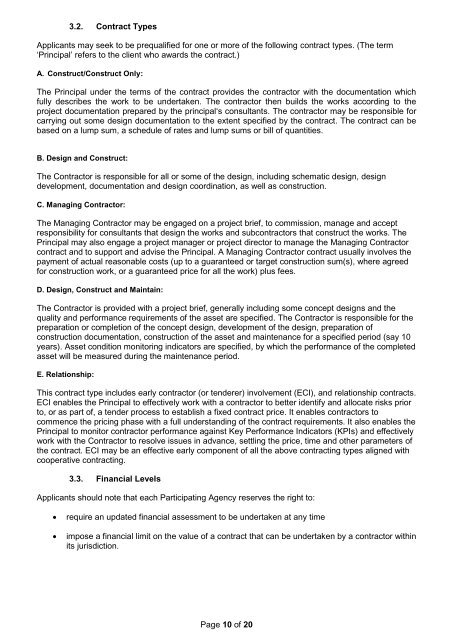
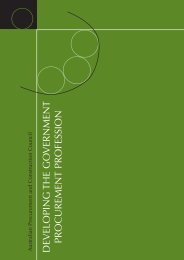
![NATIONAL COST ADJUSTMENT PROVISION EDITION 2 [NCAP2]](https://img.yumpu.com/48266135/1/184x260/national-cost-adjustment-provision-edition-2-ncap2.jpg?quality=85)
